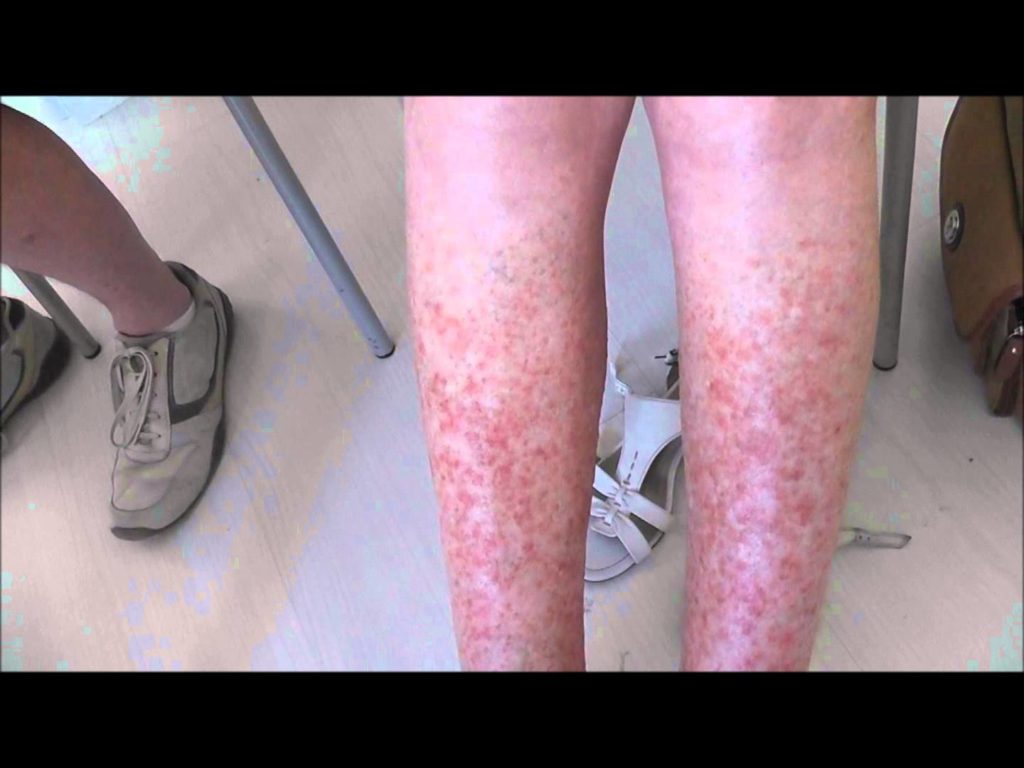Introduction
Polymorphic light eruption is a fairly common skin rash triggered by exposure to sunlight or artificial ultraviolet (UV) light.
An itchy or burning rash appears within hours, or up to two to three days after exposure to sunlight. It lasts for up to two weeks, healing without scarring.
The rash usually appears on the parts of the skin exposed to sunlight – typically the head and neck, chest and arms (the face isn’t always affected).
Polymorphic light eruption is thought to affect about 10-15% of the UK population.
What does the rash look like?
The rash can take many different forms (known as being “polymorphic”):
most people get crops of 2-5mm pink or red raised spots
some people get blisters that turn into larger, dry red patches (looks a bit like eczema)
less commonly, the skin patches look like targets or bulls-eyes, a bit like the skin rash erythema multiforme
It can be easy to mistake polymorphic light eruption for prickly heat. Prickly heat is caused by warm weather or overheating, rather than sunlight or UV light. The skin in prickly heat doesn’t “harden” or desensitise, as it can do in polymorphic light eruption (see information on desensitisation below).
How big a problem is it?
The skin rash may be a rare occurrence, or may happen every time the skin is exposed to sunlight. It ranges from mild to severe.
Sometimes, as little as 30 minutes of sun exposure is enough to cause the problem, and it can develop even through window glass or thin clothing.
However, for most people with polymorphic light eruption, the rash develops after several hours outside on a sunny day. If further sun is avoided, the rash may settle and go without a trace within a couple of weeks. It may or may not return when skin is re-exposed to sunlight.
If the skin is exposed to more sunlight before the rash has cleared up, it will probably get much worse and spread.
For many affected people, the skin rash appears every spring and remains a problem throughout summer, settling by autumn.
Who’s affected?
Polymorphic light eruption is more common in women than men. It particularly affects those who are fair, although it can affect those with dark skin.
It usually starts from the ages of 20 to 40, although it sometimes affects children.
What is the cause?
Polymorphic light eruption is thought to be caused by UV light altering a substance in the skin, which the immune system then reacts to, resulting in the skin becoming inflamed.
Polymorphic light eruption can run in families and about a fifth of affected people will have an affected relative.
It’s not infectious – there’s no risk of catching polymorphic light eruption from another person.
How is it treated?
There’s no cure for polymorphic light eruption, but careful avoidance of the sun and using sunscreens will help you manage the rash.
Generally, avoid the sun between 11am and 3pm, and wear protective clothing when outdoors (unless you’re hardening your skin; see below). Introduce your skin to sunlight gradually in the spring.
Sunscreen
You may be prescribed sunscreens, which may prevent the rash developing.
Use a sunscreen that is SPF 30 or above with a good UVA rating. Apply it thickly and evenly, reapplying often. Watch a video on how to apply sunscreen.
Steroid creams and ointments
Your GP can prescribe corticosteroid (steroid) cream or ointment, to be applied only when the rash appears. You should apply this sparingly, as often as your GP advises, and never when there’s no rash.
Desensitisation or UV treatment
Sometimes you can increase the resistance of your skin to the sun. This involves visiting a hospital department three times a week for four to six weeks in the spring.
Your skin is gradually exposed to a little more UV light every visit, to try to build up your skin’s resistance. The effects of desensitisation are lost in the winter, so you’ll have to build up your resistance again in the spring.
Hardening or toughening
You may be able to increase the resistance of your skin at home, which is known as “hardening”. This involves going outside for short periods in the spring to build up your resistance.
You might find the time is as short as a few minutes at first, but you may be able to gradually build up to longer times. You’ll have to be careful not to overdo it, but as you understand more about how much light triggers your rash, you’ll be able to judge how long to stay out.
The effects of hardening are lost in the winter, so you’ll have to build up your resistance again in the spring.
Vitamin D
People with polymorphic light eruption are at greater risk of vitamin D deficiency, as a certain amount of sun exposure is needed to make your own vitamin D. Your GP will advise whether you need treatment with vitamin D supplements.
What’s the outlook?
Many people with polymorphic light eruption find the skin complaint improves over years – the skin may harden (become more resistant to sunlight) during the summer, which means more and more sun can be tolerated without the skin reacting. It may even eventually clear up on its own, although this is unusual.
However, hardening of the skin doesn’t always happen, and some people with very sensitive skin may even get the rash in the winter. For these people, it may be a long-term condition to manage with lifestyle changes and creams.
